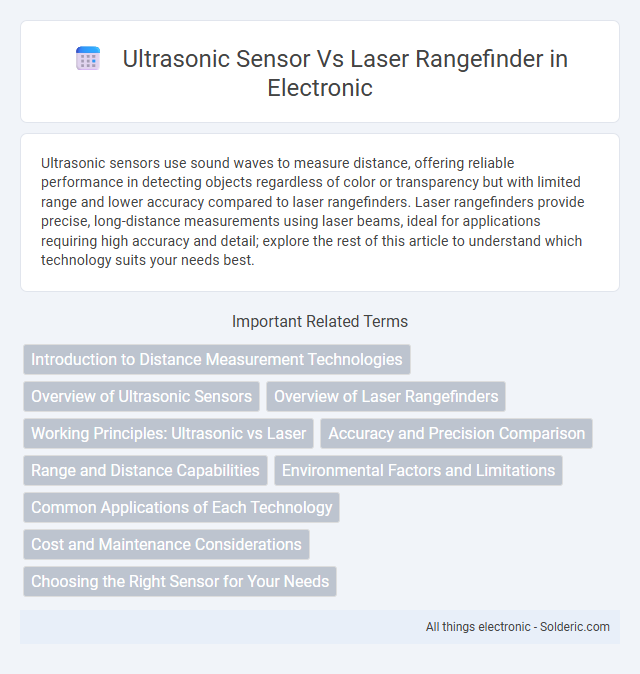Ultrasonic sensors use sound waves to measure distance, offering reliable performance in detecting objects regardless of color or transparency but with limited range and lower accuracy compared to laser rangefinders. Laser rangefinders provide precise, long-distance measurements using laser beams, ideal for applications requiring high accuracy and detail; explore the rest of this article to understand which technology suits your needs best.
Comparison Table
| Feature | Ultrasonic Sensor | Laser Rangefinder |
|---|---|---|
| Measurement Principle | Sound wave reflection | Laser light reflection |
| Range | Typically up to 10 meters | Up to several hundred meters |
| Accuracy | +-1 to 3 cm | +-1 mm to 1 cm |
| Resolution | Low (cm-level) | High (mm-level) |
| Response Time | Slow to moderate | Fast |
| Performance in Ambient Conditions | Affected by temperature, humidity, and noise | Less affected by environmental conditions |
| Surface Compatibility | Works well with most surfaces, including soft/irregular | Best on reflective, hard surfaces |
| Cost | Low to moderate | Moderate to high |
| Applications | Obstacle detection, liquid level, robotics | Surveying, industrial measurement, long-distance detection |
Introduction to Distance Measurement Technologies
Ultrasonic sensors measure distance by emitting sound waves and calculating the time it takes for the echo to return, making them effective for detecting objects within short to medium ranges. Laser rangefinders use laser beams to measure the time of flight of light pulses, offering higher precision and longer measurement ranges compared to ultrasonic sensors. Your choice between these technologies depends on the required accuracy, range, and environmental conditions of your application.
Overview of Ultrasonic Sensors
Ultrasonic sensors use high-frequency sound waves to measure distance by emitting pulses and calculating the time it takes for echoes to return after hitting an object. These sensors are commonly applied in robotics, automotive parking assistance, and industrial automation due to their low cost, reliability, and ability to detect non-reflective surfaces. While ultrasonic sensors excel in short to medium-range detection (typically up to 5 meters), they are less precise and have lower resolution compared to laser rangefinders.
Overview of Laser Rangefinders
Laser rangefinders use focused laser beams to measure precise distances by calculating the time it takes for the light to reflect back from a target, offering high accuracy and long-range capabilities up to several kilometers. They are commonly used in applications such as surveying, forestry, and military targeting where exact distance measurements and minimal interference from ambient conditions are critical. Laser rangefinders provide faster response times and superior resolution compared to ultrasonic sensors, making them ideal for situations requiring detailed spatial analysis.
Working Principles: Ultrasonic vs Laser
Ultrasonic sensors measure distance by emitting high-frequency sound waves and calculating the time it takes for the echo to return after reflecting off an object. Laser rangefinders use a laser beam to determine distance by measuring the time of flight of the light pulse or phase shift of the reflected laser signal. Ultrasonic sensors are effective in various environmental conditions but have lower resolution, while laser rangefinders provide higher accuracy and longer range with precise optical targeting.
Accuracy and Precision Comparison
Ultrasonic sensors typically offer moderate accuracy with measurement errors ranging from 1 to 3 centimeters, making them suitable for general distance detection in short to medium ranges. Laser rangefinders provide superior precision, often achieving accuracy within a millimeter by using coherent light to measure time-of-flight or phase shift, enabling detailed and reliable distance measurements over longer distances. The choice between ultrasonic and laser rangefinding technology depends on the required measurement resolution, environmental conditions, and application-specific tolerance for error.
Range and Distance Capabilities
Ultrasonic sensors typically measure distances up to 4-10 meters with accuracy affected by environmental conditions, making them suitable for short-range applications. Laser rangefinders offer significantly longer ranges, often exceeding 100 meters, with higher precision and faster response times. Your choice depends on the required distance measurement accuracy and operating environment.
Environmental Factors and Limitations
Ultrasonic sensors face limitations in environments with heavy rain, fog, or dust, as sound waves can be absorbed or scattered, reducing measurement accuracy. Laser rangefinders perform better in such conditions but struggle with reflective or transparent surfaces, which can cause erroneous distance readings. Temperature variations affect ultrasonic sensor speed of sound calculations, while laser devices are more stable but may require regular calibration to maintain precision.
Common Applications of Each Technology
Ultrasonic sensors are commonly used in automotive parking assistance, industrial automation for object detection, and liquid level measurement due to their reliability in various environmental conditions. Laser rangefinders excel in surveying, forestry, and precision mapping applications by providing high accuracy over longer distances. Both technologies are essential in robotics for obstacle detection, but laser rangefinders are preferred when detailed spatial data is required.
Cost and Maintenance Considerations
Ultrasonic sensors generally offer a lower initial cost and simpler maintenance due to their fewer moving parts and robustness in harsh environments, making them ideal for budget-conscious projects. Laser rangefinders, while more expensive upfront, often require specialized maintenance to ensure optical clarity and sensor calibration, contributing to higher long-term costs. Cost efficiency is influenced by application scale and environmental factors, with ultrasonic sensors excelling in dusty or foggy conditions where laser devices may need frequent cleaning and recalibration.
Choosing the Right Sensor for Your Needs
Ultrasonic sensors excel in short to medium range distance measurements up to several meters, offering affordability and simple integration for obstacle detection and liquid level monitoring. Laser rangefinders provide high precision and longer range capabilities, often exceeding 100 meters, ideal for applications demanding exact measurements such as surveying or industrial automation. Selecting the right sensor depends on factors like required measurement range, environmental conditions, accuracy needs, and budget constraints.
ultrasonic sensor vs laser rangefinder Infographic

 solderic.com
solderic.com